E-Archive
Good Vibrations
in Vol. 15 - July Issue - Year 2014
Drag Finishing Displaces Manual And Robotic Grinding & Polishing
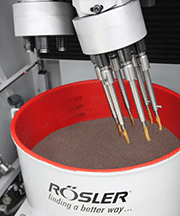
Compact drag finisher: Carousel with powered multi spindle work
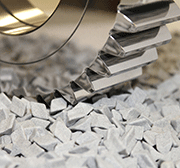
Smooth surface and gently rounded edges irrespective of part shape or size
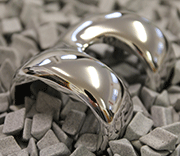
Knee implants made from high alloy steel
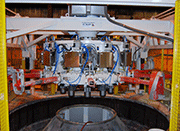
Maxi Drag carousel with work stations in load/unload position
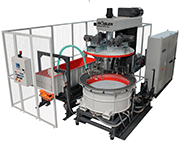
Compact drag finisher with media replenishment system
Whoever would have thought that a merry-go-round carousel would provide the inspiration for a high tech mass finishing method? But that is exactly what happened, when in the early 1980's, some smart people had the idea of mounting their work pieces on work stations and "dragging" them through a bowl filled with grinding media similar to the movement of a carousel. Since then drag finishing has evolved into a highly sophisticated technology that produces excellent, all-around homogeneous and absolutely repeatable surface finishes. It has not only done away with tedious, dirty and costly manual grinding operations, but in many instances, because of its cost efficiency and process reliability, it has displaced robotic grinding and buffing systems as well.
Mass finishing is all about pressure and speed! The media - for either grinding or polishing purposes - is constantly "rubbing" against the parts to be treated. The higher the speed of this rubbing action and the higher the pressure exerted by the media on the parts, the faster the finishing objectives are achieved. And in this respect, drag finishing is absolutely outstanding! The parts are dragged through the stationary media with speeds of up to 5 m/second producing an enormous pressure. It is not surprising that drag finishing is about 40 times faster than vibratory systems, and it still beats high-energy systems by a factor of five. For this reason, drag finishing is ideal for finishing parts made from hard to machine metals like stainless steel, titanium, tool steel, etc. Conversely, with light metal parts, it drastically reduces the required process times.
No part-on-part contact and an all-around perfect finish
Drag finishers consist of an electrically driven carousel with generally 4 - 12 workstations, each holding one or several work pieces, and a work bowl filled with grinding or polishing media. Frequently, the workstations are equipped with their own rotary drive system. Since the work pieces are not loosely tumbling like in vibratory or high-energy finishing systems but instead are firmly attached to the workstations, they never touch each other, thus preventing any part nicking or impingement. This is important for high value parts where scrapping even a single part can be quite costly.
During the process, the parts mounted to the work stations are totally immersed in the media. The rotary movement of the carousel and the workstations ensures an all-around media-on-part contact and generates an excellent, absolutely homogeneous, isotropic surface finish irrespective of part shape or size. If certain surface areas must not be touched during the process, they can be masked by preformed polyurethane components.
Drag finishing allows heavy-duty grinding and high gloss polishing
The drag finishing technology is practically universally applicable: Its use extends from heavy-duty grinding and edge breaking to surface smoothing and high gloss polishing for a broad range of parts from different industries. Here are a few examples of highly successful drag finishing applications:
Medical implants
In recent years, so-called compact drag finishing systems have become the standard equipment for super finishing of hip and knee joints. After machining, the parts undergo a multistage drag finishing process that produces a perfect polish with surface readings of ra < 0.02 µm.
Gear components
The major challenge for surface smoothing and edge radiusing of gears is their great variety of shapes and sizes. No problem for the compact drag finishing system: It produces a smooth surface (ra < 0.06 µm) and gently rounded edges irrespective of part shape or size, replacing costly manual and robotic grinding.
Turbine blades
After shot peening, the surface of blades for stationary gas turbines must be smoothed from ra = 60 - 70 µm to ra < 25 µm without affecting the leading and trailing edges. With turbine sizes of up to 550 x 250 mm (22 x 10") so-called maxi drag systems with suitable carousel and work bowl sizes must be utilized.
Stainless steel boat propellers
After fettling, the propeller castings go through a two-stage drag finishing process of heavy-duty surface grinding and polishing, and are ready to be installed without requiring any further processing.
Aluminum outboard boat engine components
The various die-cast components with lengths of up to 600 mm (24") require intensive surface grinding and edge radiusing prior to chromating and painting. The drag finishing process helps to drastically reduce manual grinding, produce an edge radius for improved paint adhesion, drastically reduce the rejection rate, and improve the overall paint quality.
From compact drag machines to the powerful maxi drag systems
Compact drag finishing systems with usually 4 - 6 workstations and work bowl diameters from 700 - 1,300 mm (28 - 51") are available in the market as standard equipment. They are ideal for processing small to mid-size parts like hip and knee implants, gear parts, etc. with cross sectional dimensions of up to 150 mm (6").
For larger parts produced in high volumes, the custom-engineered so-called "maxi drag" systems offer the ideal finishing solution. Their technical specifications are quite astonishing: The work bowl diameter can reach up to 5,000 mm (200"), and the work bowl itself can have a capacity of 8 - 10 metric tons of plastic or ceramic media. Depending on the size of the parts being processed, the carousel drive system may have an installed power of up to 150 kW, and each rotary workstation drive may require an additional 10 kW. Maxi-drag machines are no doubt among the largest mass finishing systems ever built.
Numerous technical features
Drag finishing has evolved into a sophisticated technology with numerous technical features:
Drive systems
In most drag machines, the workstations are equipped with a drive system that is independent from the carousel drive. For some applications, each workstation may have a multi spindle head where each spindle holding one part is rotating independently from the workstation.
Adjustable workstation angles
To allow the parts to be dragged through the media at different angles, the workstations are frequently available with an adjustable angle. In maxi drag systems where large and relatively heavy parts are processed, the workstation may have to be tilted into horizontal position for easy loading and unloading of the parts.
Work bowl
The work bowl must not only hold a substantial quantity of media. To maintain the process characteristics of the media, it must allow evacuation of the undersize media and the substantial amounts of media sludge (up to 150 kg/330 lbs per hour). For this reason, the work bowl must be equipped with special drains attached to high-performance drain pumps and sophisticated undersize media screens. For mixing the media and for easier discharge of the undersize media and sludge, the work bowl is usually equipped with a powerful vibratory drive.
Tooling
The workstations are frequently equipped with quick connect coupling systems to allow quick loading/unloading of the parts and to minimize non-productive, idle times.
Precise positioning of the carousel
To allow robotic loading/unloading of the parts, the spinner may be equipped for the precise positioning of the individual work stations.
Peripheral equipment
In order to maintain a constant media level in the work bowl, practically all drag finishing systems are equipped with replenishment systems to continuously replace the media that is lost in the form of media fines and undersize media.
Drag finishers for dry polishing must frequently be equipped with cooling systems to dissipate the heat generated by the polishing process.
Multi bowl systems
For multi-stage finishing (e.g. cut-down, surface smoothing and polishing) multi-bowl designs are available where the carousel shuttles to each individual bowl, thus eliminating non-productive times for parts loading and unloading.
Excellent finishing results, reduced scrap rates and lower piece costs
Despite their high initial investment and operating costs, drag finishers, be it compact or maxi drag systems, have proven to be highly economical. They have done away with tedious, costly manual grinding and deburring, but have also proven to produce better finishing results at lower costs compared to robotic deburring and polishing systems. Batch by batch and irrespective of part shape and size, the drag finishing process produces excellent, all-around isotropic and absolutely repeatable surface finishes. And above all, it helps to drastically reduce scrap rates and rework. With drag finishing, you can indeed have your cake and eat it: It produces better finishes at lower costs!
by Eugen Holzknecht
Contributing Editor MFN and
Rösler Oberflächentechnik GmbH
E-mail: holzknecht.usa@gmail.com
Author: Eugen Holzknecht


























